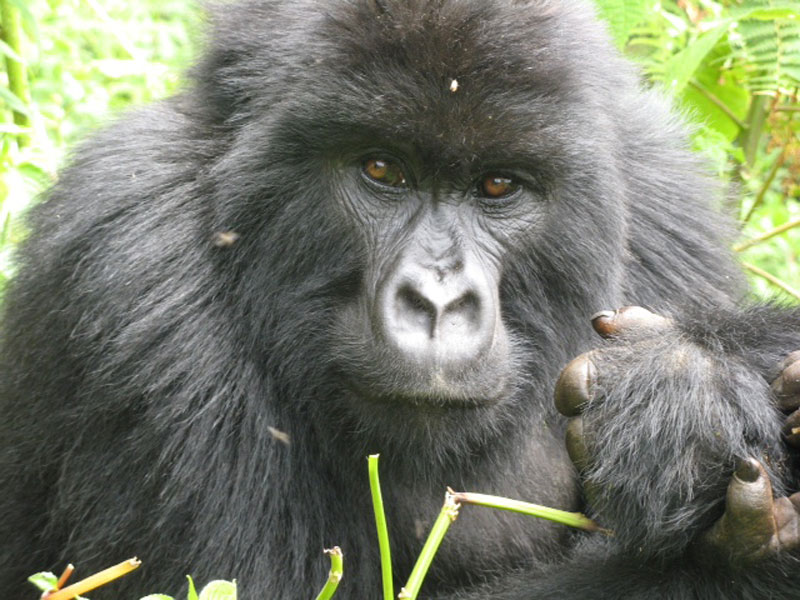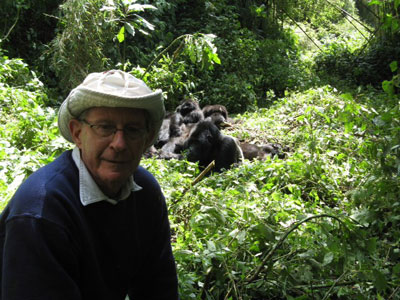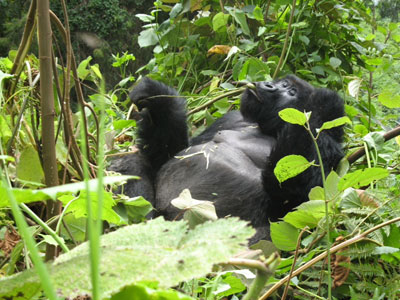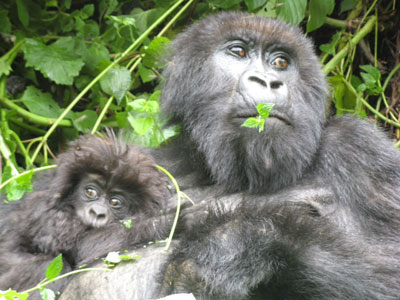A rewarding trek to see Rwanda’s mountain gorillas
This article appears on page 20 of the August 2014 issue.
by Marvin Silverman; Carmel, CA
During a world cruise on the Crystal Serenity in 2014, we arrived in Durban, South Africa, on the morning of March 24. My traveling partner, Stanley Blend, and I were picked up at the ship in the afternoon and driven to the airport. Our 20-minute drive went through areas built up with high-rise buildings, high-end residential complexes, parks and, closer to the airport, rolling green hills out to the horizon. The Durban airport was spacious and modern, with beautiful shops.
We flew to Johannesburg and, after an overnight stay, arose very early for our 4-hour flight to Kigali. I have never seen a bluer sky or whiter cloud formations with such fantastic shapes. We were traveling to the capital of Rwanda for a 4-day gorilla trek excursion.
Volcanoes National Park
Upon our arrival at Kigali International Airport, Stanley and I were met by Kevin, who would be our driver for the next two days. We stopped for lunch, at which time Kevin gave Stanley and me a brief history of Rwanda.
If you saw the movie “Hotel Rwanda,” you’ll be familiar with the terrible genocide of 1994, when approximately one million people — Tutsis and Hutus — were killed, including Kevin’s brother. From what I’ve read, and from what Kevin told us, the country has turned around and is prospering economically, and while many people have forgiven those who participated in the killings, the tragedy will never be forgotten.
After lunch, we set out on a 2-hour-and-40-minute drive to our lodge, the Mountain Gorilla View Lodge, and Volcanoes National Park, the headquarters of gorilla-viewing activity, located 20 minutes from the lodge.
Kigali is at about 5,000 feet in elevation and the lodge and park are at 7,000 feet (I’d been taking altitude pills to adjust to the elevation), so although we went up and down on our drive, the overall route was uphill.
Our route took us mainly along the top of a mountain ridge, with sharp drop-offs on either side. The hillsides across the distant valleys were terraced for farming and to prevent erosion. Everything was green except for the red volcanic soil in the fields — very pretty!
This area is a rainforest, which explained all the greenery, and it did rain intermittently during our drive.
We arrived at the Mountain Gorilla View Lodge and were each assigned a large room with a double bed and a very large bathroom. The rooms had no heat except for a tiny electric heater and a wood-burning fireplace in each. I needed both sources of heat, as it was cold at that elevation, especially after the sun went down.
We had drinks before dinner and good conversation with the other guests before going to bed early.
The next morning we were awakened at 5:30 and had a light breakfast. At 6:40 Kevin picked us up to take us to Volcanoes National Park, where we were assigned to a trekking group. There are normally a maximum of eight trekkers in a group, but we had only six.
Our trekking group was assigned to a gorilla family, one of the 10 gorilla families available for viewing in the area. Ours was named Umubano. This family had 15 members, including two silverbacks — a rarity — as well as three babies, four youngsters (under three years old), two young adult males and four females.
Our group had its own guide plus an assistant, rangers, trackers and a guy with a rifle to protect us from the Cape buffalo and elephants that also inhabit the mountain range.
Each trekker could hire a porter to be of assistance on the trek — and, believe me, without the porters, we never would have completed the trek!
So off we went on a 40-minute twisting, bouncing, jolting, back-breaking drive on a road so rocky that the rocks had rocks. Finally, we arrived at the takeoff point and were each assigned a porter and given a sturdy walking stick. Now, finally, we began our first trek, Hurray!
Through the forest
We walked in single file (one guide, six trekkers, six porters, a couple of helpers and the guy with the rifle) for about 45 minutes along paths through potato fields on level ground — easy walking. Then we came to a wall built of large rocks that marked the boundary of Volcanoes National Park. With the help of our porters, we climbed the wall, dropped to the other side and were “officially” trekking in the forest.
When I say “forest,” I don’t mean a stand of trees with some grass and small plants on the ground. To get an accurate picture, think impenetrable, thick, impassable forest with steep hills. The foliage, vines, nettles, thorns and fallen limbs made progress slow and arduous.
We started out going uphill, with the porters and guide cutting a path through the thick foliage with their machetes. Most of the time, my porter was just in front of me, putting his hand out to grasp mine to help me make one more step up the slope. The porter behind me, assisting his trekker, would sometimes give me a push in the back to help me fight gravity and proceed up the slope. And if we weren’t getting our feet tangled up in vines and branches, we were slogging through thick, slippery, clinging mud. (This is a rainforest!)
I had been told horrible stories about how the rain would soak us and make our going miserable, but we really got lucky; we had no rain this day nor the next, and even the guide and porters were amazed.
I also had been told that I would freeze because of the altitude and the chill. However, the temperature ranged between 50°F and 60°F on both days. Also, we were working so hard just putting one foot ahead of the other, it could have been 30 degrees and we would have stayed warm.
Although I was wearing hiking boots with cleats on the soles, boots I have worn in the far corners of the world, they failed me on that day. I was slipping and sliding during the entire trek and soon had gobs of mud all over my pants.
Oh, did I mention the thorns and nettles? There were lots of plants with leaves edged with sharp points and others with long thorns. I was wearing heavy rubberized gardening gloves, so my hands were OK, but the thorns and nettles penetrated my pants and I soon felt as if my legs had been jabbed with 1,000 needles. Well, if you can’t stand the thorns, stay off the mountain!
While we were fighting our way through this green monster called a forest, there were rangers up ahead radioing to our guide the present location of the Umubano family, which was on the move. As we continued to get these location advisories, we would alter our route to head toward the last reported location.
Our ascent took 1 hour and 20 minutes, and we climbed to over 8,000 feet; it was the hardest sustained exertion I have ever experienced in my life. I am glad I try to keep myself in good shape.
Gorilla encounters
Then came the gorillas! Once we saw them, our permitted 60 minutes began. Our first sighting was of two young males feeding in a tree about 25 feet away. Our guide and porters made guttural gorilla sounds to make them feel at ease.
The gorillas were climbing up and down, ripping leaves off the trees and eating them. When they decided to go elsewhere, they didn’t just climb down; they simply let go and fell 10 to 15 feet, landing on their backs in a pile of vegetation.
After a few minutes for photos, we moved farther up the mountainside to look for more gorillas.
The photo ops were random and iffy. Sometimes a branch would be in the way, and many times the gorillas would turn their backs to us, but we all had many opportunities to get great shots.
At one point we came across the second-in-rank silverback lying on his back on a cluster of bushes out in the open. He was lazily stretching out his arm to pluck a branch and pull it through his mouth to strip off the leaves.
We were told this gorilla had tried to steal some of the ladies from the alpha silverback and was bitten severely for this no-no. According to the guide, he was now content to sit back and wait for the alpha male to make a big mistake or die.
We next came across two youngsters about two years old, each weighing about 100 pounds, playing and fighting with each other just like grandkids do.
We were standing about three feet from them. The official required distance is seven meters (23 feet), but a number of gorillas came much closer to us. At one point, the guide called out to me to stand still, and, from behind me, two of the adult females, each weighing over 200 pounds, came lumbering past me, their fur brushing my pants. They didn’t pay any attention to me, and I sure as heck didn’t offer to shake hands with them!
I have to say that I never, on either day, had a feeling of danger or unease. The gorillas seemed to be so placid and easygoing that it was hard to imagine them fighting with each other.
Fantastic finale
Of course, the high point for many trekkers is to see the silverback of the family, and with five minutes to go in our allotted time, we met him. As we came into a clearing, there he was, Mr. Charlie, with his silvery back to us and a couple of youngsters playing nearby.
He finally, with two minutes to go, turned his head and looked at us. He was a monster, about 450 pounds. What a great ending to our trek!
Except we weren’t finished yet. We still had to fight our way down the mountain and through the jungle, cutting a path, slipping, sliding and getting tangled and tripped by vines.
We only had to get down to level ground, at 7,000 feet, but, having a history of pulmonary problems, I found breathing tough at that height. We finally made it, then walked 45 more minutes back through the potato fields to our vehicles.
In all, it took us four hours from leaving the vehicles to our return to them. But what an incredible, once-in-a-lifetime experience — worth every slip, fall and thorn prick. And I was going to do it again the next day!
A new experience
In the morning we drove to the taking-off point, different from the previous day’s, as we would be trekking in another part of the park. We met our porters, received our walking sticks and heard an informative talk from our guide about the gorilla family that we would see that day, the Agashya family.
As we entered the forest, I noticed that it was very different from the previous day’s. This was a bamboo forest; instead of large leafy trees, the forest was 80% bamboo, and they were very tall and very thick, with many fallen stalks.
The incline up the mountainside was also much easier to climb, perhaps a 20-degree incline at its steepest.
We did not have to cut a path through the forest, instead walking along paths that the Cape buffalo that live in the area had made. However, not only did the buffalo walk along these paths, they also pooped on them… prodigiously. Because it had rained heavily several days before we arrived, these paths were thick with mud, and the buffaloes’ contribution made for a slippery, dangerous trek.
Thank goodness for my porter, who held my hand and guided me to the less slippery areas. By the time we found the gorillas, my hiking boots were muddy right up to the top.
After about 40 minutes of trekking, we saw our first gorilla, a silverback! He was lying on his stomach on a pile of leafy branches in a sunny opening in the forest, and every silver hair on his back glistened in the sun. Glorious!
In our 60 minutes, we saw 10 of the 23 Agashya family members. After the trek, we returned to the lodge, showered, had lunch and were driven back to Kigali and a hotel. We were awakened at 11:30 p.m., were taken to the Kigali airport and caught a 3 a.m. flight to Nairobi.
After a layover of several hours, we took a flight from Nairobi to Jo’burg, sat around for another couple of hours and took a final flight at 3 p.m. to Cape Town, where we were picked up and driven back to our Crystal Cruises ship, which had arrived in Cape Town the day before.
Three flights in one day, starting at 3 a.m., might sound tough, but it was nothing compared to climbing that mountain!
With hiking at high altitude, thrashing through vines and brambles, slogging through mud and climbing extremely steep slopes, it took all I had to get through each trek. All the hard work I had put in every day for years — stretching, lifting weights and pounding out 30 tough minutes on my exercycle — paid off.
Our trekking trip cost each of us $5,400 plus $300 for meals and tips. It was one of the highlights of my traveling life.
Editor’s note: While gorilla trekking permits can be booked independently at the Rwanda Development Board’s Tourism & Conservation Reservation Office (Boulevard de l’Umuganda, Gishushu, Nyarutarama Road, Kigali, Rwanda; phone +252 57 65 14 or email reservation@rwandatourism.com), arrangements for Mr. Silverman’s trip were made through a tour operator.




